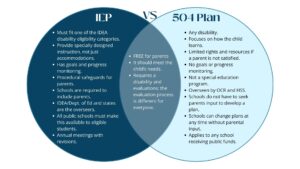IEP vs. 504 Plan
By Morgan Kimball
Individualized Educational Plan (IEP) 
Throughout school, I had an IEP, and I never really knew what that meant. All I knew was that I got pulled out of the classroom for extra help in reading. What does IEP stand for? IEP means Individualized Educational Plan. This is a developed plan for a child who has a learning struggle or disability and receives specialized instruction and related services. Normally, with an IEP, students are pulled out of their regular classroom to receive additional support that will help the student close the gap between the student and their peers.
504 Plan
The 504 Plan is developed to ensure that a child who has a learning struggle or disability receives accommodations that will ensure their academic success. A 504 Plan is designed to provide the student with access to resources that help level the playing field between the student and their peers. With a 504 plan, students will get help within their regular classroom. Now, I probably had a 504 Plan, too, because I remember having all kinds of accommodations and extra help in the classroom.
Differences?
Not all students who have learning disabilities are required to have specialized instruction. For those students who need specialized instruction, an IEP is developed. The Individuals with Disabilities Education Act (IDEA), is a federal special education law for children with disabilities, controls the procedural requirements for an IEP. An IEP is more involved than a 504 Plan. An IEP is a detailed plan outlining what the school will provide the student (the support needed, who provides the support, how many times per week, how many minutes per session, etc.) and requires documentation of growth. An IEP focuses on educational benefits and often includes direct services such as speech or occupational therapy, etc.
For those students who don’t need specialized instruction but need the assurance they will receive equal access to public education and services, a 504 Plan outlines their special accessibility requirements. Section 504 of the Rehabilitation Act of 1973 is a federal civil rights law to stop discrimination against people with disabilities. In other words, a 504 Plan is geared towards ensuring a student has equitable access to a learning environment.

In summary, the main difference between an IEP and a 504 Plan is the level of support and the focus on specialized instruction. IEPs are more comprehensive and are designed for students who require specialized educational services, while 504 Plans primarily focus on providing accommodations to ensure equal access to the general education curriculum for students with disabilities. The choice between the two depends on the individual needs of the student and is determined through a formal evaluation and eligibility process.
